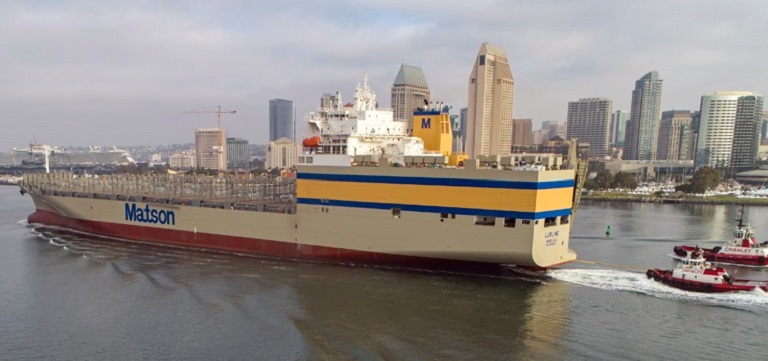Matson, Inc. (NYSE: MATX), a leading U.S. carrier in the Pacific, took delivery of its newest vessel on Dec 26, the largest combination container / roll-on, roll-off ("con-ro") ship ever built in the United States, from General Dynamics NASSCO.

Christened 'Lurline,' the new ship is the first of two "Kanaloa Class" con-ro vessels being built for Matson by NASSCO at a total cost of approximately $500 million for the pair, and the third of four new vessels that Matson is putting into service between 2018 and 2020. Lurline will make its maiden voyage to Hawaii next month, departing Oakland and Long Beach on January 9 and January 11, respectively, and arriving in Honolulu on January 15.
Named in honor of the ocean deity revered in the native Hawaiian culture, Matson's Kanaloa Class ships are built on a 3,500 TEU* vessel platform.
At 870 feet long, 114 feet wide (beam), with a deep draft of 38 feet and weighing in at over 50,000 metric tons, Lurline is now Matson's largest ship and the largest con-ro vessel ever constructed in the U.S. It is also one of Matson's fastest vessels, with a top speed of 23 knots, helping ensure on-time deliveries in Hawaii from Matson's three West Coast terminals in Seattle, Oakland and Long Beach.
Both new Kanaloa Class vessels will have an enclosed garage with room for approximately 500 vehicles, plus ample space for rolling stock and breakbulk cargo. They will also feature state-of-the-art green technology, including a fuel-efficient hull design, environmentally safe double hull fuel tanks, fresh water ballast systems and the first Tier 3 dual fuel engines to be deployed in containerships serving West Coast ports. Both new vessels will enter service fully compliant with new International Maritime Organization (IMO) emission regulations going into effect January 1, 2020.
Under the latest IMO requirements for engine manufacturers, Tier 3 engines reduce the levels of particulate emissions by 40 percent and nitrogen oxide emissions by 20 percent, as compared to Tier 2 standards.
Source: Matson